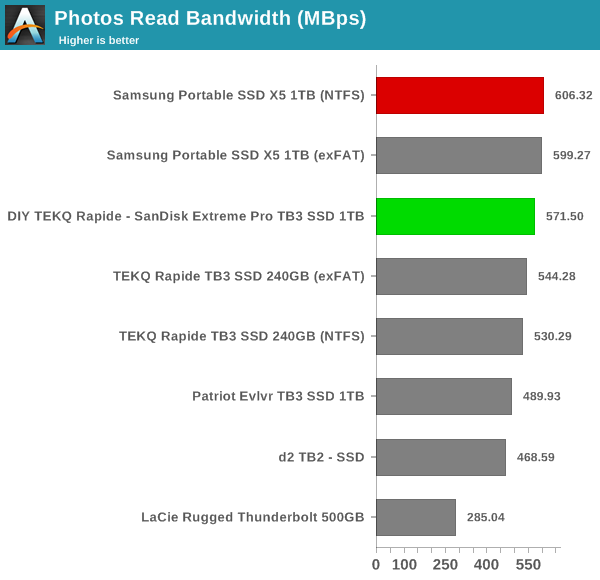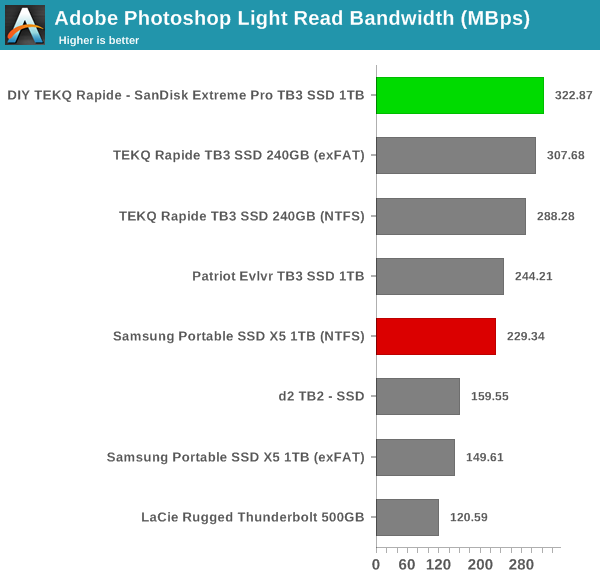The Samsung Portable SSD X5 Review - Thunderbolt 3 and NVMe in a Premium Enclosure
by Ganesh T S on August 28, 2018 10:00 AM ESTAnandTech DAS Suite and Performance Consistency
This section looks at how the Samsung Portable SSD X5 fares in real-life workloads.
Benchmarks - robocopy and PCMark 8 Storage Bench
Our testing methodology for DAS units also takes into consideration the usual use-case for such devices. The most common usage scenario is transfer of large amounts of photos and videos to and from the unit. The minor usage scenario is importing files directly off the DAS into a multimedia editing program such as Adobe Photoshop.
In order to tackle the first use-case, we created three test folders with the following characteristics:
- Photos: 15.6 GB collection of 4320 photos (RAW as well as JPEGs) in 61 sub-folders
- Videos: 16.1 GB collection of 244 videos (MP4 as well as MOVs) in 6 sub-folders
- BR: 10.7 GB Blu-ray folder structure of the IDT Benchmark Blu-ray (the same that we use in our robocopy tests for NAS systems)

For the second use-case, we take advantage of PC Mark 8's storage bench. The storage workload involves games as well as multimedia editing applications. The command line version allows us to cherry-pick storage traces to run on a target drive. We chose the following traces.
- Adobe Photoshop (Light)
- Adobe Photoshop (Heavy)
- Adobe After Effects
- Adobe Illustrator
Usually, PC Mark 8 reports time to complete the trace, but the detailed log report has the read and write bandwidth figures which we present in our performance graphs. Note that the bandwidth number reported in the results don't involve idle time compression. Results might appear low, but that is part of the workload characteristic. Note that the same testbed is being used for all DAS units. Therefore, comparing the numbers for each trace should be possible across different DAS units.

Performance Consistency
Yet another interesting aspect of these types of units is performance consistency. Aspects that may influence this include thermal throttling and firmware caps on access rates to avoid overheating or other similar scenarios. This aspect is an important one, as the last thing that users want to see when copying over, say, 100 GB of data to the flash drive, is the transfer rate going to USB 2.0 speeds. In order to identify whether the drive under test suffers from this problem, we instrumented our robocopy DAS benchmark suite to record the flash drive's read and write transfer rates while the robocopy process took place in the background. For supported drives, we also recorded the internal temperature of the drive during the process. The graphs below show the speeds observed during our real-world DAS suite processing. The first three sets of writes and reads correspond to the photos suite. A small gap (for the transfer of the videos suite from the primary drive to the RAM drive) is followed by three sets for the next data set. Another small RAM-drive transfer gap is followed by three sets for the Blu-ray folder.
An important point to note here is that each of the first three blue and green areas correspond to 15.6 GB of writes and reads respectively. Throttling, if any, is apparent within the processing of the photos suite itself.
| Performance Consistency and Thermal Characteristics |
/PCON.png) |
The temperature of the X5 does not cross 55C in our stress test. That said, we see some differences in the transfer rates from one run to the next for the same data set. It looks likely that the thermal management features are at play (given that Samsung wants to maintain the internal SSD around 45C), but, we also want to rule out the SLC cache running out. The test outlined in our next section clears up that aspect.










23 Comments
View All Comments
HStewart - Tuesday, August 28, 2018 - link
I search around this drive is $700 for 1T and I hope since Intel has open up the spec for TB 3 - that the prices would drop. I have also heard that new controller will be backwards compatible with USB 3.x - of course at much slower speed.One thing that would be nice in review - is compare a similar drive using USB 3.x - actually both Gen 1 and Gen 2.
Reflex - Wednesday, August 29, 2018 - link
Someone mentioned recently that despite Intel's statement that they would open up TB3, it hasn't yet happened and communication on the topic has ceased. I haven't looked into it myself yet, but if true that implies that it really won't ever go mass market or get much cheaper.The_Assimilator - Thursday, August 30, 2018 - link
In that case, TB has cemented its legacy as Firewire's successor, and in a few years will vanish entirely unless Intel decides to keep it on extended life support.shelbystripes - Tuesday, August 28, 2018 - link
The throttling scheme is by far the most concerning part of this. I doubt there are firmware changes that could enable greater performance at the same temperature... but I wonder if Samsung could release firmware to increase the maximum internal temperature. 56C seems a bit low as a threshold, given that the thermal protection works as planned. Perhaps raising the throttling threshold to 60-65C could increase performance? The older 850 EVO series was rated up to 70C, and AnandTech preciously reported that the 970 EVO (which this is supposedly based on) gives thermal warnings at 85C.Running hot might have a small effect on shelf life, but I doubt most people will be writing 100GB+ to it constantly.
I would be pissed if I used one of these to make an initial backup and it took several hours due to throttling, but if that one-time load was successful, incremental changes shouldn’t hit the higher thermal threshold at all.
shelbystripes - Tuesday, August 28, 2018 - link
Previously, not previously. It’s 2018, why don’t comments have an edit button?shelbystripes - Tuesday, August 28, 2018 - link
Sigh.jordanclock - Tuesday, August 28, 2018 - link
If it means the NAND lasts longer, I think it's a fair trade off.shelbystripes - Tuesday, August 28, 2018 - link
It depends on how balanced the trade off is. 56C seems rather low given the higher thermal limits on other SSDs, and seems to be heavily impacting performance after just a couple minutes of sustained transfer. Raising it to 60-65C shouldn’t heavily impact long term lifespan, since their desktop version can handle higher temperatures just fine.I have trouble believing the durability impact, just from raising the throttle temp into the 60-65C range, is so massive that it justifies this much throttling. Especially since this is a mobile device, which isn’t going to serve as a boot drive or anything like that.
notashill - Tuesday, August 28, 2018 - link
It's 1C cooler than the TEKQ model and 1/10 the performance, in spite of a larger and heavier package.Dug - Wednesday, August 29, 2018 - link
Where do you get 1/10 the performance from?